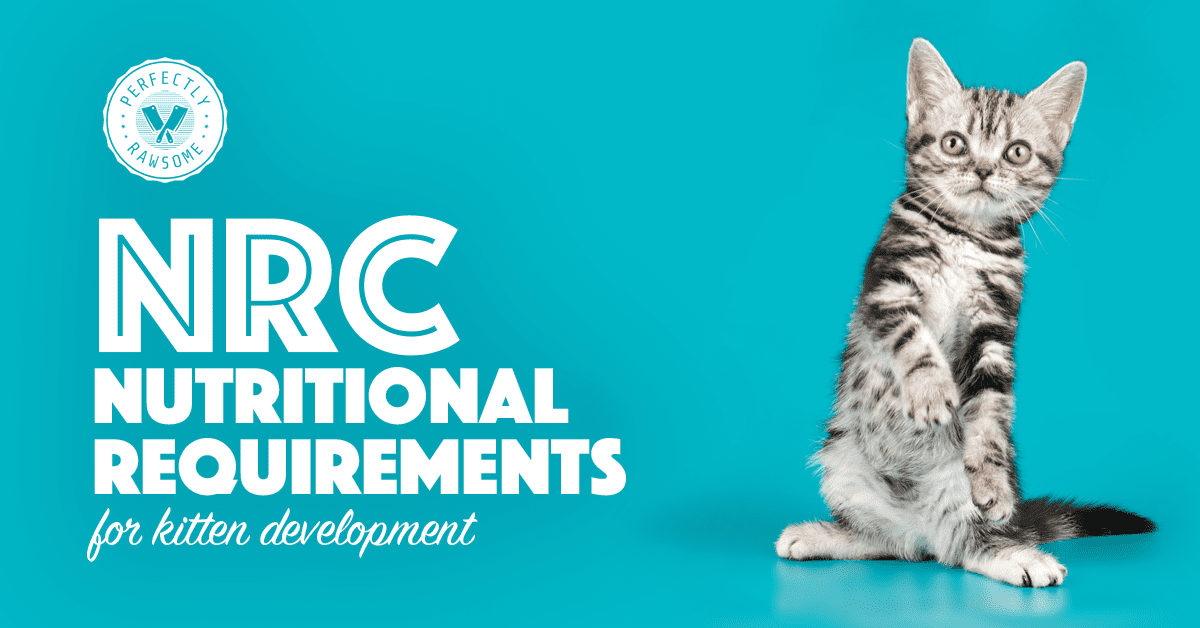Kittens cannot regulate vitamins and nutrients over time like an adult cat. Therefore, kittens require a daily balanced diet. Prey Model Raw (PMR) ratios provide guidelines on items to include in a raw diet to provide essential nutrients and recommended calories for proper growth and development.
The ingredients included in a kitten’s raw diet need to be selected to ensure recommended allowances for all essential nutrients are met daily.

Macronutrients for Kittens
Macronutrients are the nutrient categories that are necessary for optimal health. There are three primary macronutrients. These include protein (amino acids), lipids (fats), and carbohydrates. Each macronutrient is found in nearly all foods and they supply calories for energy.
Recommended Daily Allowances for Macronutrients
Macronutrients are a class of chemical compounds which are consumed in large quantities and provide the bulk of energy within the diet.
Proteins are large complex molecules composed of amino acids and are the main structural component of body tissue. Kittens do not have a nutritional requirement for protein because the body can synthesize new proteins with amino acids and nitrogen. However, kittens do have requirements for specific amino acids, carbon skeletons, and nitrogen.
Protein supplied in food provides essential amino acids, carbon skeletons, and nitrogen to fulfill these nutritional requirements. The primary role of protein is to supply amino acids for muscle and organ protein synthesis, the creation of enzymes, the creation of hormones, and energy.
The National Research Council (NRC) provides the following protein recommendations for kittens after weaning per 1000kcal consumed:
Minimum: 45g
Recommended Allowance: 56.3g
Data Source:
National Research Council. Nutrient Requirements of Dogs and Cats. National Academies Press, 2007.
Fat provides nutritional compounds to supply kittens with energy, essential fatty acids (EFAs), and is a vehicle for nutrient absorption and transportation. Fat is the primary source of energy for cats, particularly growing kittens. Therefore, providing a raw diet with sufficient amounts of fat is important to optimal health and development.
The National Research Council (NRC) provides the following fat recommendations for kitten after weaning per 1000kcal consumed:
Recommended Allowance: 22.5g
Maximum: 82.5g
Data Source:
National Research Council. Nutrient Requirements of Dogs and Cats. National Academies Press, 2007.
For humans and dogs, carbohydrates are another source of energy and supply the body with glucose once digested and metabolized. However, cats are obligate carnivores and it is not recommended to feed carbohydrates to kittens. Glucose requirements can be met through precursor nutrients, glycogenic amino acids or glycerol from fats, through gluconeogenesis.
The National Research Council (NRC) does not provide carbohydrate recommendations for kittens.
Data Source:
National Research Council. Nutrient Requirements of Dogs and Cats. National Academies Press, 2007.
Water accounts for a large portion of the total amount of food ingested in a normal raw diet. Water does not provide any nutritional value. However, water is an essential nutrient necessary for optimal feline health and nutrition.
Micronutrients for Kittens
Kittens have different micronutrient requirements in comparison to adult cats. Kittens have higher requirements for amino acids, fats, vitamins, and minerals in comparison to adult cats and these nutrients must be supplied in sufficient amounts in the diet.
Recommended Daily Allowances for Essential Nutrients
Nutritional Research Council (NRC) provides the following Recommended Allowances (RA) for kittens 12 months and younger per 1000kcal consumed:
| Nutrient | RA | Minimum | Maximum |
|---|---|---|---|
| Arginine | 02.40 g | 01.93 g | 8.75 g |
| Histidine | 0.83 g | 0.65 g | 5.5 g |
| Isoleucine | 1.40 g | 1.08 g | 21.7 g |
| Leucine | 3.20 g | 2.55 g | 21.7 g |
| Lysine | 2.10 g | 1.70 g | 14.5 g |
| Methionine | 1.10 g | 0.88 g | 3.25 g |
| Methionine + Cystine | 2.20 g | 1.75 g | – |
| Phenylalanine | 1.30 g | 1.00 g | 7.25 g |
| Phenylalanine + Tyrosine | 4.80 g | 3.83 g | 17.0 g |
| Threonine | 1.60g | 1.30 g | 12.7 g |
| Tryptophan | 0.40 g | 0.33 g | 4.25 g |
| Valine | 1.60 g | 1.28 g | 21.7 g |
| Taurine | 1.10 g | 0.08 g | 2.22 g |
Data Source:
National Research Council. Nutrient Requirements of Dogs and Cats. National Academies Press, 2007.
* If a homemade raw diet is fed ground then a taurine supplement is required. *
| Nutrients | RA | Minimum | Maximum |
|---|---|---|---|
| Linoleic Acid | 1.40 g | – | 13.8 g |
| α-Linolenic Acid | 0.05 g | – | – |
| Arachidonic Acid | 0.05 g | – | – |
| Eicosapentaenoic + Docosahexaenoic Acid (EPA/DHA) | 0.025 g | – | – |
Data Source:
National Research Council. Nutrient Requirements of Dogs and Cats. National Academies Press, 2007.
| Nutrient | RA | Minimum | Maximum |
|---|---|---|---|
| Vitamin A | 833 RE* | – | 66,666 RE* |
| Vitamin D | 1.4 mcg | 0.70 mcg | 188 mcg |
| Vitamin E | 9.4 mg | – | – |
* Vitamin A: 1 IU is the biological equivalent of 0.3 micrograms (mcg) retinol
Data Source:
National Research Council. Nutrient Requirements of Dogs and Cats. National Academies Press, 2007.
| Nutrient | RA | Minimum | Maximum |
|---|---|---|---|
| Vitamin B1 (Thiamine) | 1.4 mg | 1.1 mg | – |
| Vitamin B2 (Riboflavin) | 1.0 mg | – | – |
| Vitamin B3 (Niacin) | 10 mg | – | – |
| Vitamin B5 (Pantothenic Acid) | 1.43 mg | 1.15 mg | – |
| Vitamin B6 (Pyridoxine) | 0.625 mg | 0.5 mg | – |
| Vitamin B7 (Biotin) | 18.75 mcg | – | – |
| Vitamin B9 (Folate & Folic acid) | 188 mcg | 150 mg | – |
| Vitamin B12 (Cobalamin) | 5.6 mcg | – | – |
| Choline | 637 mg | 510 mg | – |
Data Source:
National Research Council. Nutrient Requirements of Dogs and Cats. National Academies Press, 2007.
| Nutrient | RA | Minimum | Maximum |
|---|---|---|---|
| Calcium | 2.0 g | 1.3 g | – |
| Phosphorus | 1.8 g | 1.2 g | – |
| Magnesium | 100 mg | 40 mg | – |
| Potassium | 1.0 g | 0.67 g | – |
| Sodium | 350 mg | 310 mg | – |
| Chloride | 225 mg | 190 g | – |
Data Source:
National Research Council. Nutrient Requirements of Dogs and Cats. National Academies Press, 2007.
| Nutrient | RA | Minimum | Maximum |
|---|---|---|---|
| Iron | 20 mg | 17 mg | – |
| Copper | 2.1 mg | 1.1 mg | – |
| Zinc | 18.5 mg | 12.5 mg | – |
| Manganese | 1.2 mg | – | – |
| Selenium | 75 mcg | 30 mcg | – |
| Iodine | 450 mcg | – | – |
* There is data to suggest that the NRC recommended allowance for iodine for cats and kittens is too high.
Data Source:
National Research Council. Nutrient Requirements of Dogs and Cats. National Academies Press, 2007.
When combining recommended allowances for essential nutrients with raw feeding ratio guidelines, a balanced raw diet using whole foods can be achieved to supply an kitten with the appropriate nutrition to support optimal growth and development.
Raw Feeding Ratio Guidelines
A raw diet is divided into percentages, known as ratio guidelines, to provide an estimate on how much of each ingredient is needed. PMR ratios are a guideline for the amount of muscle meat, raw meaty bones, organs, and fiber to include in a raw diet for a kitten.
Similar to maintenance percentages, raw diet ratios are to be used as a guideline when selecting ingredients and creating a raw diet. Once maintenance percentages are calculated, ratio guidelines can be determined.
Example 1
Kitten profile in english units:
3 Months Old
5 Pounds
400 Calories
Estimated Caloric Need
8oz Intake
Estimated Daily Intake
Calculate ratio guidelines in english units:
Kitten PMR Ratios
8 x 0.69 = 5.52oz muscle meat
8 x 0.17 = 1.36oz edible bone
8 x 0.07 = 0.56oz liver
8 x 0.07 = 0.56oz other organ
Example 2
Kitten profile in metric units:
3 Months Old
2.3 Kilograms
400 Calories
Estimated Caloric Need
227g Intake
Estimated Daily Intake
Calculate ratio guidelines in metric units:
Kitten PMR Ratios
227 x 0.69 = 156.6g muscle meat
227 x 0.17 = 38.6g edible bone
227 x 0.07 = 15.9g liver
227 x 0.07 = 15.9g other organ
Adapting Ratio Guidelines into a Balanced Diet
Ratio calculations provide a guideline on ingredients to include in a raw diet. Each ingredient provides essential nutrients to use when formulating a balanced raw diet for kittens.
Muscle Meat
The muscle meat portion of raw ratios assists in supplying protein, amino acids, fats, vitamins (water soluble B vitamins), and some minerals.
Raw Meaty Bones
The main role of the edible bone ratio is to supply calcium within a raw diet. Raw meaty bones provide muscle meat and edible bone which assists in supplying protein, amino acids, fats, and minerals (calcium and phosphorus).
Liver
The liver ratio assists in supplying protein, amino acids, vitamins (vitamin A and B vitamins), and minerals (mainly copper). Ruminant liver will provide sufficient copper while pork and poultry will not.
Secreting Organs
The secreting organ ratio assists in supplying protein, amino acids, vitamins (B vitamins), and minerals (mainly iron). Spleen is the only organ that provides enough iron for kittens. If spleen is not available, a supplement will likely be required.
Fiber
Traditional PMR ratio guidelines fail to include fiber-based foods, which would be present in true whole prey feeding. Therefore, including an animal-based fiber source is recommended. Adding foods that include fur or feathers, provides insoluble fiber to the diet to promote colon health. If those are not available, psyllium husk is an appropriate alternative.
* The PMR ratios are guidelines to use as a starting point in building a home prepared raw diet for kittens. Ratio diets are not nutritionally complete without certain additional whole foods and/or supplements.
CLOSING COMMENTS
Kittens lack the ability to regulate nutrients like adult cats and require daily nutritional balance. Since kittens require multiple meals a day, each meal does not need to be individually balanced. However, the total amount of calories and nutrients fed in one day must provide all essential nutrients necessary for optimal growth and development.
Macronutrients
Macronutrients should be met daily to ensure growing kittens are provided with a sufficient amount of calories for energy.
Micronutrients
Amino acids, fatty acids, vitamins, and minerals are all essential nutrients necessary for optimal growth and development.
Raw Diet Ratios
The ratios for muscle meat, raw edible bone, organs and fiber provide a guide on which ingredients to select to include in a raw diet for kittens.
Raw diet ratios provide guidance on which ingredients and their amounts to use when formulating a diet for a growing kitten. However, it is important to note these are merely guidelines to use as a starting point. These are not “rules” and adjustments should be made to complete recommended allowances for essential macro and micronutrients. Ratio diets are not nutritionally complete without certain additional whole foods and/or supplements.
